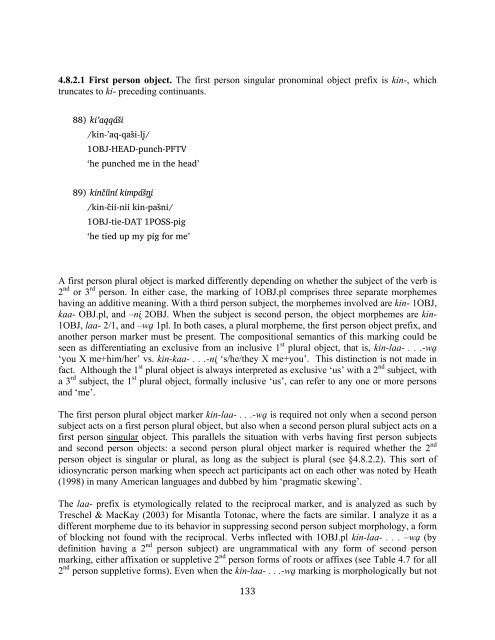The phonology and morphology of Filomeno Mata Totonac
The phonology and morphology of Filomeno Mata Totonac
The phonology and morphology of Filomeno Mata Totonac
You also want an ePaper? Increase the reach of your titles
YUMPU automatically turns print PDFs into web optimized ePapers that Google loves.
4.8.2.1 First person object. <strong>The</strong> first person singular pronominal object prefix is kin-, which<br />
truncates to ki- preceding continuants.<br />
88) ki’aqqás%i<br />
/kin-’aq-qas"i-li&/<br />
1OBJ-HEAD-punch-PFTV<br />
‘he punched me in the head’<br />
89) kinc%íiní kimpás%n&i&<br />
/kin-c"ii-nii kin-pas"ni/<br />
1OBJ-tie-DAT 1POSS-pig<br />
‘he tied up my pig for me’<br />
A first person plural object is marked differently depending on whether the subject <strong>of</strong> the verb is<br />
2 nd or 3 rd person. In either case, the marking <strong>of</strong> 1OBJ.pl comprises three separate morphemes<br />
having an additive meaning. With a third person subject, the morphemes involved are kin- 1OBJ,<br />
kaa- OBJ.pl, <strong>and</strong> –ni" 2OBJ. When the subject is second person, the object morphemes are kin-<br />
1OBJ, laa- 2/1, <strong>and</strong> –w! 1pl. In both cases, a plural morpheme, the first person object prefix, <strong>and</strong><br />
another person marker must be present. <strong>The</strong> compositional semantics <strong>of</strong> this marking could be<br />
seen as differentiating an exclusive from an inclusive 1 st plural object, that is, kin-laa- . . .-w!<br />
‘you X me+him/her’ vs. kin-kaa- . . .-ni" ‘s/he/they X me+you’. This distinction is not made in<br />
fact. Although the 1 st plural object is always interpreted as exclusive ‘us’ with a 2 nd subject, with<br />
a 3 rd subject, the 1 st plural object, formally inclusive ‘us’, can refer to any one or more persons<br />
<strong>and</strong> ‘me’.<br />
<strong>The</strong> first person plural object marker kin-laa- . . .-w! is required not only when a second person<br />
subject acts on a first person plural object, but also when a second person plural subject acts on a<br />
first person singular object. This parallels the situation with verbs having first person subjects<br />
<strong>and</strong> second person objects: a second person plural object marker is required whether the 2 nd<br />
person object is singular or plural, as long as the subject is plural (see §4.8.2.2). This sort <strong>of</strong><br />
idiosyncratic person marking when speech act participants act on each other was noted by Heath<br />
(1998) in many American languages <strong>and</strong> dubbed by him ‘pragmatic skewing’.<br />
<strong>The</strong> laa- prefix is etymologically related to the reciprocal marker, <strong>and</strong> is analyzed as such by<br />
Treschel & MacKay (2003) for Misantla <strong>Totonac</strong>, where the facts are similar. I analyze it as a<br />
different morpheme due to its behavior in suppressing second person subject <strong>morphology</strong>, a form<br />
<strong>of</strong> blocking not found with the reciprocal. Verbs inflected with 1OBJ.pl kin-laa- . . . –w! (by<br />
definition having a 2 nd person subject) are ungrammatical with any form <strong>of</strong> second person<br />
marking, either affixation or suppletive 2 nd person forms <strong>of</strong> roots or affixes (see Table 4.7 for all<br />
2 nd person suppletive forms). Even when the kin-laa- . . .-w! marking is morphologically but not<br />
! "''!

















